ASRock Industrial NUCS BOX-1360P/D4 Review: Raptor Lake-P Impresses, plus Surprise ECC
by Ganesh T S on January 29, 2023 9:30 AM EST- Posted in
- Systems
- NUC
- UCFF
- Mini-PC
- ASRock Industrial
- Raptor Lake-P
GPU Performance: Synthetic Benchmarks
Intel did not make significant changes in the integrated GPU when moving from Alder Lake to Raptor Lake. Process maturity has allowed it to clock the iGPU a bit higher, but the number of EUs remains the same as in the previous generation. GPU performance evaluation typically involved gaming workloads, and for select PCs, GPU compute. Prior to that, we wanted to take a look at the capabilities of the iGPU in the Core i7-1360P. Unfortunately, GPU-Z doesn't yet recognize the 'new' GPU, but HWiNFO has more helpful information.
We have seen earlier that the performance of the Intel Iris Xe Graphics is miles ahead of previous iGPUs from both Intel and AMD. The benchmarks processed on the NUCS BOX-1360P/D4 back up that aspect.
GFXBench
The DirectX 12-based GFXBench tests from Kishonti are cross-platform, and available all the way down to smartphones. As such, they are not very taxing for discrete GPUs and modern integrated GPUs. We processed the offscreen versions of the 'Aztec Ruins' benchmark.
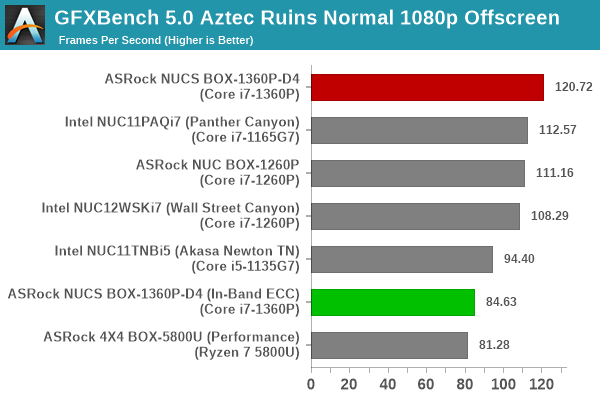
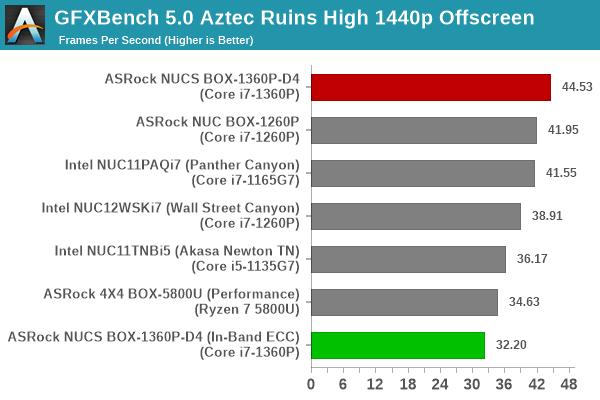
Raptor Lake-P's higher iGPU clocks enable it to come out on top, but enabling ECC makes the performance suffer badly.
UL 3DMark
Four different workload sets were processed in 3DMark - Fire Strike, Time Spy, Night Raid, and Wild Life.
3DMark Fire Strike
The Fire Strike benchmark has three workloads. The base version is meant for high-performance gaming PCs. It uses DirectX 11 (feature level 11) to render frames at 1920 x 1080. The Extreme version targets 1440p gaming requirements, while the Ultra version targets 4K gaming system, and renders at 3840 x 2160. The graph below presents the overall score for the Fire Strike Extreme and Fire Strike Ultra benchmark across all the systems that are being compared.
| UL 3DMark - Fire Strike Workloads | |||
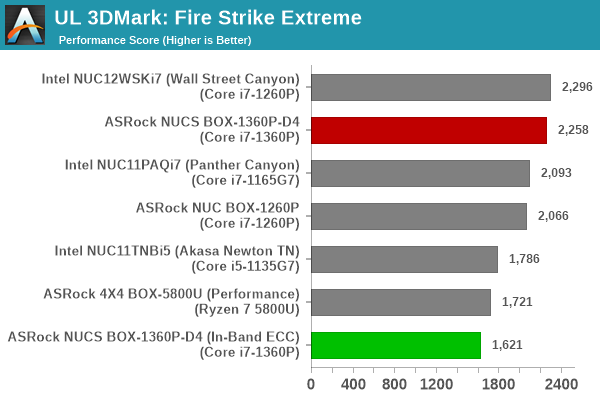
3DMark Time Spy
The Time Spy workload has two levels with different complexities. Both use DirectX 12 (feature level 11). However, the plain version targets high-performance gaming PCs with a 2560 x 1440 render resolution, while the Extreme version renders at 3840 x 2160 resolution. The graphs below present both numbers for all the systems that are being compared in this review.
| UL 3DMark - Time Spy Workloads | |||
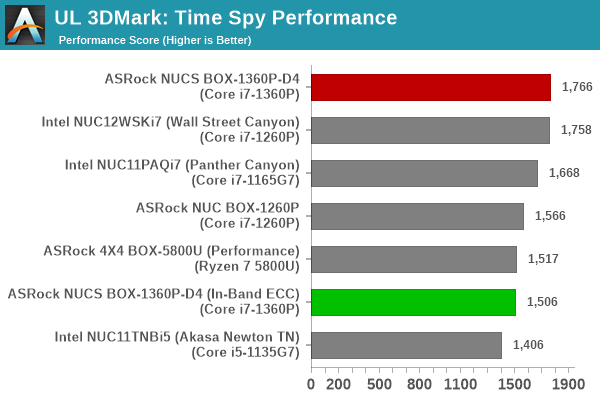
3DMark Wild Life
The Wild Life workload was initially introduced as a cross-platform GPU benchmark in 2020. It renders at a 2560 x 1440 resolution using Vulkan 1.1 APIs on Windows. It is a relatively short-running test, reflective of mobile GPU usage. In mid-2021, UL released the Wild Life Extreme workload that was a more demanding version that renders at 3840 x 2160 and runs for a much longer duration reflective of typical desktop gaming usage.
| UL 3DMark - Wild Life Workloads | |||
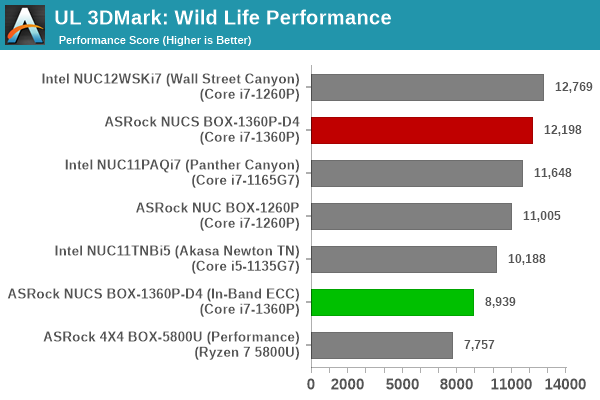
3DMark Night Raid
The Night Raid workload is a DirectX 12 benchmark test. It is less demanding than Time Spy, and is optimized for integrated graphics. The graph below presents the overall score in this workload for different system configurations.
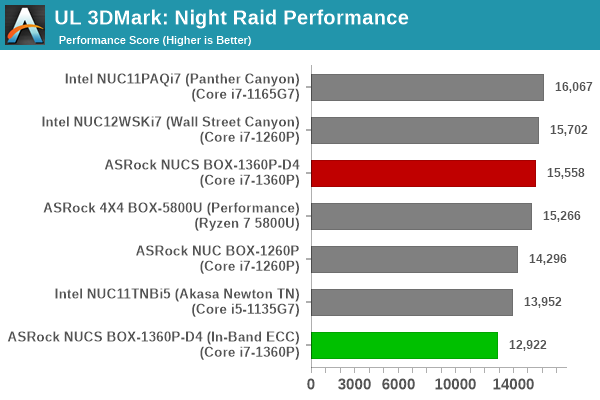
The Wall Street Canyon NUC and the NUCS BOX-1360P/D4 are pretty much neck-to-neck in the 3D Mark workloads. In these benchmarks that run relatively longer than GFXBench, the PL1 also starts coming into the picture. The Wall Street Canyon NUC has an edge in that aspect. Other than that, it is no surprise that the pattern of external memory accesses generated in the 3D Mark workloads is detrimental to performance when ECC is enabled.


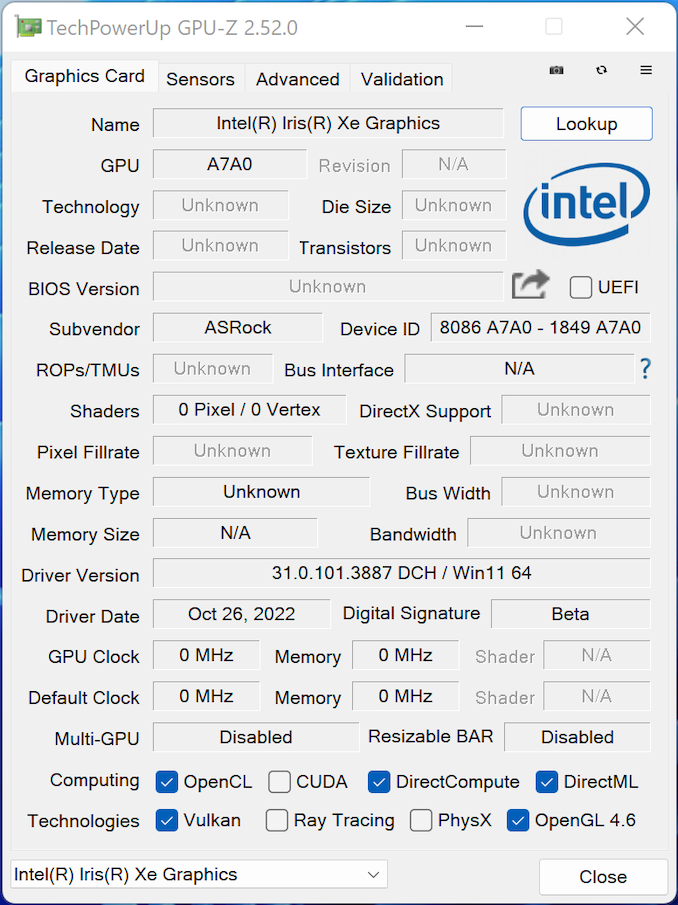
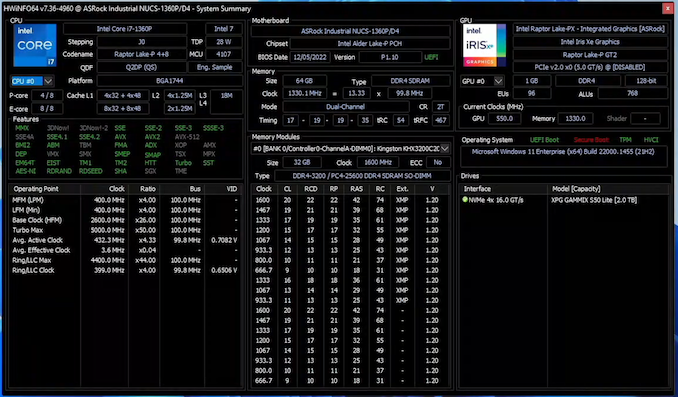








30 Comments
View All Comments
AntonErtl - Saturday, February 4, 2023 - link
Given that ECC error reports are extremely rare on our systems (with typically 128GB of RAM), I don't worry about having more than one error in 512 bits. Even when a DIMM failed, it resulted in 19 ECC errors (18 uncorrectable) in 14 hours, probably noticed by scrubbing (regular walks through memory to detect whether a bit has flipped).HideOut - Sunday, January 29, 2023 - link
You linked the wrong item for barebones. You linked the old model.ganeshts - Monday, January 30, 2023 - link
Yes, the target page will get updated with the additional new model once Newegg is ready to sell them (as per the info I have from ASRock Industrial). If the URL changes, I will update it. For now, the system has just started entering the channel and is not available for end-user purchase yet.GhostOfAnand - Monday, January 30, 2023 - link
Good work, G-man. I liked the expose on this in-band ECC business. Discussion here: https://www.realworldtech.com/forum/?threadid=2104...notR1CH - Tuesday, January 31, 2023 - link
I would love to see some video tests at non-standard resolutions like "5K" (5120x2160). I have a couple of kiosks that run weird display resolutions and would love to use a NUC to power them, but with the official specs only going up to 4K I've not wanted to risk it not working.abufrejoval - Saturday, February 4, 2023 - link
Well, it stands to reason that the in-band ECC option would be physically available on all recent SoCs, because nobody can resist maximizing cut & paste IP blocks.But with Intel NUCs, there is literally no chance whatsoever they'd support that on non-industrial SKUs, because it's a chance to charge double.
So I wonder if they won't force OEMs to disable that 'rogue' feature, much like AES512 or some of the recent BLK overclocking gimmicks.
I don't even mind paying an ECC premium on hardware I run 24x7, because in those cases compromised data would cost much more. But you can't buy "ECC-variants" of common NUCs and recently even buying ECC variant mainboards of classical desktop chipsets e.g. W680 has become next to impossible, when that was relatively easy say in Haswell times.
Don't know if it's because it's too niche or if Intel is somehow actively discouraging that market. AMD came to rescue until it went with DDR5, where ECC variants were "unobtainium".
All I can say is that I'd be happy to throw €100 at the ability to activate in-band ECC for any SoC that phyiscally supports it, even in a notebook that might get recycled as a server after it's no longer fit for the roadtrips.
AntonErtl - Saturday, February 4, 2023 - link
W680 boards are available in Germany and Austria, but they are expensive (>EUR 440).DDR5 UDIMMs with ECC are available in Germany and Austria from Kingston at ~EUR 210 for a 32GB UDIMM. Note that unlike for AM4, Asrock apparently no longer supports ECC with AM5, currently leaving ASUS as only supplyer for those of us who want ECC. At least AMD officially supports ECC in all socketed Ryzen 7000 CPUs up to now.
mode_13h - Tuesday, February 14, 2023 - link
> Asrock apparently no longer supports ECC with AM5Even ASRock Rack? They've announced AM5 boards, but I'm not sure if they're yet shipping.
AntonErtl - Wednesday, March 1, 2023 - link
There are no Asrock Rack AM5 boards listed on geizhals.at yet, so those may or may not support ECC when they become available.If this is an attempt by Asrock to get us to buy the more expensive Asrock Rack boards, it will fail: We will just buy ASUS.
mode_13h - Sunday, March 5, 2023 - link
BTW, the only ECC DDR5 UDIMMs I'm seeing are all DDR5-4800. I think it'll be a while before we see anything much faster.This could be a point in favor of in-band ECC, if only support for it would be more widespread.